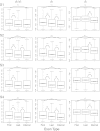The evolution of the coding exome of the Arabidopsis species--the influences of DNA methylation, relative exon position, and exon length
- PMID: 24965500
- PMCID: PMC4079183
- DOI: 10.1186/1471-2148-14-145
The evolution of the coding exome of the Arabidopsis species--the influences of DNA methylation, relative exon position, and exon length
Abstract
Background: The evolution of the coding exome is a major driving force of functional divergence both between species and between protein isoforms. Exons at different positions in the transcript or in different transcript isoforms may (1) mutate at different rates due to variations in DNA methylation level; and (2) serve distinct biological roles, and thus be differentially targeted by natural selection. Furthermore, intrinsic exonic features, such as exon length, may also affect the evolution of individual exons. Importantly, the evolutionary effects of these intrinsic/extrinsic features may differ significantly between animals and plants. Such inter-lineage differences, however, have not been systematically examined.
Results: Here we examine how DNA methylation at CpG dinucleotides (CpG methylation), in the context of intrinsic exonic features (exon length and relative exon position in the transcript), influences the evolution of coding exons of Arabidopsis thaliana. We observed fairly different evolutionary patterns in A. thaliana as compared with those reported for animals. Firstly, the mutagenic effect of CpG methylation is the strongest for internal exons and the weakest for first exons despite the stringent selective constraints on the former group. Secondly, the mutagenic effect of CpG methylation increases significantly with length in first exons but not in the other two exon groups. Thirdly, CpG methylation level is correlated with evolutionary rates (dS, dN, and the dN/dS ratio) with markedly different patterns among the three exon groups. The correlations are generally positive, negative, and mixed for first, last, and internal exons, respectively. Fourthly, exon length is a CpG methylation-independent indicator of evolutionary rates, particularly for dN and the dN/dS ratio in last and internal exons. Finally, the evolutionary patterns of coding exons with regard to CpG methylation differ significantly between Arabidopsis species and mammals.
Conclusions: Our results suggest that intrinsic features, including relative exonic position in the transcript and exon length, play an important role in the evolution of A. thaliana coding exons. Furthermore, CpG methylation is correlated with exonic evolutionary rates differentially between A. thaliana and animals, and may have served different biological roles in the two lineages.
Figures




Similar articles
-
Position-dependent correlations between DNA methylation and the evolutionary rates of mammalian coding exons.Proc Natl Acad Sci U S A. 2012 Sep 25;109(39):15841-6. doi: 10.1073/pnas.1208214109. Epub 2012 Sep 10. Proc Natl Acad Sci U S A. 2012. PMID: 23019368 Free PMC article.
-
DNA methylation is associated with an increased level of conservation at nondegenerate nucleotides in mammals.Mol Biol Evol. 2014 Feb;31(2):387-96. doi: 10.1093/molbev/mst208. Epub 2013 Oct 24. Mol Biol Evol. 2014. PMID: 24157417 Free PMC article.
-
Lineage-specific sequence evolution and exon edge conservation partially explain the relationship between evolutionary rate and expression level in A. thaliana.Mol Ecol. 2015 Jun;24(12):3093-106. doi: 10.1111/mec.13221. Epub 2015 Jun 5. Mol Ecol. 2015. PMID: 25930165 Free PMC article.
-
Not all exons are protein coding: Addressing a common misconception.Cell Genom. 2023 Apr 12;3(4):100296. doi: 10.1016/j.xgen.2023.100296. eCollection 2023 Apr 12. Cell Genom. 2023. PMID: 37082142 Free PMC article. Review.
-
An evolutionary case for functional gene body methylation in plants and animals.Genome Biol. 2017 May 9;18(1):87. doi: 10.1186/s13059-017-1230-2. Genome Biol. 2017. PMID: 28486944 Free PMC article. Review.
Cited by
-
Universality of the DNA methylation codes in Eucaryotes.Sci Rep. 2019 Jan 17;9(1):173. doi: 10.1038/s41598-018-37407-8. Sci Rep. 2019. PMID: 30655579 Free PMC article.
-
Notos - a galaxy tool to analyze CpN observed expected ratios for inferring DNA methylation types.BMC Bioinformatics. 2018 Mar 27;19(1):105. doi: 10.1186/s12859-018-2115-4. BMC Bioinformatics. 2018. PMID: 29587630 Free PMC article.
-
Evidence for Adaptive Introgression of Disease Resistance Genes Among Closely Related Arabidopsis Species.G3 (Bethesda). 2017 Aug 7;7(8):2677-2683. doi: 10.1534/g3.117.043984. G3 (Bethesda). 2017. PMID: 28630104 Free PMC article.
References
-
- Carvalho RF, Feijao CV, Duque P. On the physiological significance of alternative splicing events in higher plants. Protoplasma. 2012. [Epub ahead of print] - PubMed
-
- Keren H, Lev-Maor G, Ast G. Alternative splicing and evolution: diversification, exon definition and function. Nat Rev Genet. 2010;11(5):345–355. - PubMed
Publication types
MeSH terms
LinkOut - more resources
Full Text Sources
Other Literature Sources

